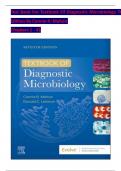Test Bank For Textbook Of Diagnostic Microbiology 7t
Edition By Connie R. Mahon
Chapters 1 - 41
, Mahon:KTextbookKofKDiagnosticKMicrobiology,K7thKEditionKTestKBank
TableKofKcontents
PartK1:KIntroductionKtoKClinicalKMicrobiology
ChapterK1.KBacterialKCellKStructure,KPhysiology,KMetabolism,KandKGenetics
ChapterK2.KHost-ParasiteKInteraction
ChapterK3.KTheKLaboratoryKRoleKinKInfectionKControl
ChapterK4.KControlKofKMicroorganisms:KDisinfection,KSterilization,KandKMicrobiologyKSafety
ChapterK5.KPerformanceKImprovementKinKtheKMicrobiologyKLaboratory
ChapterK6.KSpecimenKCollectionKandKProcessing
ChapterK7.KMicroscopicKExaminationKofKMaterialsKfromKInfectedKSites
ChapterK8.K UseKofKColonyKMorphologyKforKtheKPresumptiveKIdentificationKofKMicroorganisms
ChapterK9.K BiochemicalKIdentificationKofKGram-NegativeKBacteria
ChapterK10.KImmunodiagnosisKofKInfectiousKDiseases
ChapterK11.KApplicationsKofKMolecularKDiagnostics
ChapterK12.KAntibacterialKMechanismsKofKActionKandKBacterialKResistanceKMechanisms
ChapterK13.KAntimicrobialKSusceptibilityKTesting
PartK2:KLaboratoryKIdentificationKofKSignificantKIsolates
ChapterK14.KStaphylococci
ChapterK15.KStreptococcus,KEnterococcus,KandKOtherKCatalase-Negative,KGram-PositiveKCocci
ChapterK16.KAerobicKGram-PositiveKBacilli
ChapterK17.KNeisseriaKSpeciesKandKMoraxellaKcatarrhalis
ChapterK18.KHaemophilus,KHACEK,KLegionellaKandKOtherKFastidiousKGram-NegativeKBacilli
ChapterK19.KEnterobacteriaceae
ChapterK20.KVibrio,KAeromonas,KandKCampylobacterKSpecies
ChapterK21.KNonfermentingKandKMiscellaneousKGram-NegativeKBacilli
ChapterK22.KAnaerobesKofKClinicalKImportance
ChapterK23.KTheKSpirochetes
ChapterK24.KChlamydia,KRickettsia,KandKSimilarKOrganisms
ChapterK25.KMycoplasmaKandKUreaplasma
ChapterK26.KMycobacteriumKtuberculosisKandKNontuberculousKMycobacteria
ChapterK27.KMedicallyKSignificantKFungi
ChapterK28.KDiagnosticKParasitology
ChapterK29.KClinicalKVirology
ChapterK30.KAgentsKofKBioterrorKandKForensicKMicrobiology
ChapterK31.KBiofilms:KArchitectsKofKDisease
PartK3:KLaboratoryKDiagnosisKofKInfectiousKDiseases:KandKOrganKSystemKApproachKtoKDiagnosticKMicrobiology
ChapterK32.KUpperKandKLowerKRespiratoryKTractKInfections
ChapterK33.KSkinKandKSoftKTissueKInfections
ChapterK34.KGastrointestinalKInfectionsKandKFoodKPoisoning
ChapterK35.KInfectionsKofKtheKCentralKNervousKSystem
ChapterK36.KBacteremiaKandKSepsis
ChapterK37.KUrinaryKTractKInfections
ChapterK38.KGenitalKInfectionsKandKSexuallyKTransmittedKInfections
ChapterK39.KInfectionsKinKSpecialKPopulations
ChapterK40.KZoonoticKDiseases
ChapterK41.KOcularKInfections
-
,ChapterK01:KBacterialKCellKStructure,KPhysiology,KMetabolism,KandKGeneticsKMa
hon:KTextbookKofKDiagnosticKMicrobiology,K7thKEditionKTestKBank
MULTIPLEKCHOICE
1. ToKsurvive,KmicrobialKinhabitantsKhaveKlearnedKtoKadaptKbyKvaryingKallKofKtheKfollowing,Kexcept
a. growthKrate.
b. growthKinKallKatmosphericKconditions.
c. growthKatKparticularKtemperatures.
d. bacterialKshape.
ANSWER:K D
TheKchapterKbeginsKbyKdiscussingKtheKwayKmicrobialKinhabitantsKhaveKhadKtoKevolveKtoKsurviv
eKinKmanyKdifferentKnichesKandKhabitats.KItKdiscussesKslowKgrowers,KrapidKgrowers,KandKreplica
tionKwithKscarceKorKabundantKnutrients,KunderKdifferentKatmosphericKconditions,Ktemperatur
eKrequirements,KandKcellKstructure.KBacterialKshapeKasKaKformKofKevolutionKisKnotKdiscussed.
OBJ:K LevelK2:KInterpretation
2. WhoKwasKconsideredKtheKfatherKofKprotozoologyKandKbacteriology?
a. AntonKvanKLeeuwenhoek
b. LouisKPasteur
c. CarlKLandsteiner
d. MichaelKDouglas
ANSWER:K A
TheKbookKdiscussesKAntonKvanKLeeuwenhoekKasKtheKinventorKofKtheKmicroscopeKandKtheKfirstK
personKtoKseeKtheK“beasties.”KSoKtheyKdubbedKhimKtheKfatherKofKprotozoologyKandKbacteriolo
gy.KTheKotherKthreeKindividualsKwereKnotKdiscussed.
OBJ:K LevelK1:KRecall
3. ProkaryoticKcellsKhaveKwhichKofKtheKfollowingKstructuresKinKtheirKcytoplasm?
a. GolgiKapparatus
b. Ribosomes
c. Mitochondria
d. EndoplasmicKreticulum
ANSWER:K B
AllKtheKstructuresKlistedKareKfoundKinKeukaryoticKcells,KbutKribosomesKareKtheKonlyKonesKth
atKapplyKtoKprokaryoticKcells.
OBJ:K LevelK1:KRecall
4. ThisKformKofKDNAKisKcommonlyKfoundKinKeukaryoticKcells.
a. Linear
b. Circular
c. Plasmid
d. Colloid
.
.
, ANSWER:K A
CircularKandKplasmidKDNAKareKusuallyKfoundKonlyKinKbacteria,KnotKeukaryoticKcells.KColloidKisKaK
propertyKofKproteinKmoleculesKandKisKnotKassociatedKwithKnucleotides.
OBJ:K LevelK1:KRecall
5. TheKnuclearKmembraneKinKprokaryotesKis
a. missing.
b. impenetrable.
c. aKclassicKmembrane.
d. aKlipidKbilayerKmembrane.
ANSWER:K A
ProkaryoticKcellsKdoKnotKhaveKanyKmembrane-
boundKstructuresKinKtheKcytoplasmKincludingKaKstructuredKnucleus.
OBJ:K LevelK1:KRecall
6. AKmicroorganismKthatKisKaKunicellularKorganismKandKlacksKaKnuclearKmembraneKandKtru
eKnucleusKbelongsKtoKwhichKclassification?
a. Fungi
b. Bacteria
c. Algae
d. Parasite
ANSWER:K B
Fungi,Kalgae,KandKparasitesKareKunicellularKeukaryoticKorganismsKthatKcontainKaKtrueKnucleu
s.KBacteriaKareKprokaryoticKandKdoKnotKcontainKaKtrueKnucleusKorKnuclearKmembrane.
OBJ:K LevelK1:KRecall
7. InKtheKlaboratory,KtheKclinicalKmicrobiologistKisKresponsibleKforKallKtheKfollowing,Kexcept
a. isolatingKmicroorganisms.
b. selectingKtreatmentKforKpatients.
c. identifyingKmicroorganisms.
d. analyzingKbacteriaKthatKcauseKdisease.
ANSWER:K B
ClinicalKmicrobiologistsKdoKnotKselectKtheKtreatmentKforKpatients.KTheyKprovideKtheKdoctorKwit
hKtheKnameKofKtheKorganismKandKtheKantibioticsKthatKcanKkillKtheKbacteria,KbutKnotKinKtheKfinalK
selectionKofKtreatmentKprotocols.
OBJ:K LevelK2:KRecall
8. WhatKenablesKtheKmicrobiologistKtoKselectKtheKcorrectKmediaKforKprimaryKcultureKandKoptimi
zeKtheKchanceKofKisolatingKaKpathogenicKorganism?
a. DeterminingKstainingKcharacteristics
b. UnderstandingKtheKcellKstructureKandKbiochemicalKpathwaysKofKanKorganism
c. UnderstandingKtheKgrowthKrequirementsKofKpotentialKpathogensKatKspecificKbodyKsite
d. KnowingKtheKdifferencesKinKcellKwallsKofKparticularKbacteria
ANSWER:K C




